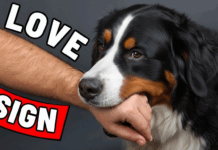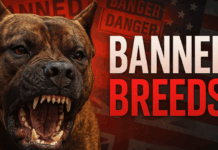Last Updated on April 8, 2023 by Dogs Vets
The Secret Language of Dogs: How to Understand Your Furry Friend’s Signals
Understanding your dog’s secret language is crucial for building a strong bond and ensuring their well-being. Our furry friends may not speak our language, but they communicate with us through various signals and behaviors.
In this comprehensive guide, we will delve into the fascinating world of canine communication and provide you with practical tips to better understand your dog’s needs and emotions.
Decoding Your Dog’s Body Language
The Tail: A Window Into Your Dog’s Emotions
Tail wagging is more than just a sign of happiness. The position and movement of your dog’s tail can provide important clues about their emotional state:
- Neutral position: When your dog’s tail is in a neutral position, it means they are relaxed and content.
- Raised tail: A raised tail indicates excitement or arousal. This could be due to playfulness, curiosity, or even aggression.
- Tucked tail: A tucked tail is a sign of fear, anxiety, or submission.
The Ears: Listening for Clues
A dog’s ears can also provide valuable information about their mood:
- Erect and forward: This shows that your dog is alert and focused on something.
- Flattened ears: Flattened ears signal fear, anxiety, or submission.
- Relaxed ears: Relaxed ears indicate that your dog is calm and content.
The Eyes: Windows to the Soul
Your dog’s eyes can be a powerful indicator of their emotions:
- Soft, round eyes: These suggest that your dog is relaxed and happy.
- Wide, staring eyes: Wide eyes can signal fear, anxiety, or aggression.
- Averted gaze: A dog averting their gaze may be showing deference or submission.
Understanding Canine Vocalizations
Barking: More Than Just Noise
Barking is a natural form of canine communication. Here are some common reasons why dogs bark:
- Attention-seeking: Your dog may bark to get your attention or ask for something.
- Warning: Barking can be a warning signal to alert you of potential threats or intruders.
- Playfulness: Dogs often bark during play as a form of social interaction.
Growling: Setting Boundaries
Growling can be an important signal that your dog is uncomfortable or feels threatened:
- Fear: A fearful dog may growl as a warning to back off.
- Aggression: Aggressive growling can be a precursor to a potential attack.
- Play: Some dogs growl during play, but this is usually accompanied by relaxed body language.
Whining: Expressing Discomfort or Anxiety
Whining can be an indicator that your dog is experiencing discomfort or anxiety. Common reasons for whining include:
- Pain: If your dog is whining and showing signs of discomfort, they may be in pain. Consult your veterinarian for advice.
- Separation anxiety: Dogs with separation anxiety may whine when left alone.
- Attention-seeking: Whining can also be a way for your dog to get your attention.
Canine Calming Signals: How Dogs Ease Tension
Dogs use calming signals to defuse tense situations and communicate their peaceful intentions. Some common calming signals include:
- Yawning: Dogs may yawn to show they are not a threat and to calm themselves.
- Lip-licking: A quick lick of the lips can be a sign that your dog is feeling anxious or stressed. 3. Turning away: Turning their head or body away from a perceived threat can be a calming signal.
- Sniffing the ground: This behavior can be a way for your dog to indicate that they are not a threat and want to avoid conflict.
- Play bow: A play bow is a friendly invitation to engage in play and can be used to diffuse tension.
Interpreting Play Behavior
Play is an essential part of a dog’s life and serves as a way for them to socialize, learn, and bond with their owners. Here are some typical play behaviors and their meanings:
Play Bow: Let the Games Begin
A play bow is when your dog lowers their front end while keeping their rear end elevated. This is an invitation to play and a sign that any following actions are meant to be playful.
Tug-of-War: Testing Boundaries
Tug-of-war is a favorite game for many dogs. It allows them to practice their natural instincts, such as grabbing and pulling, while also testing their strength and boundaries with you.
Chase and Fetch: Exercise and Mental Stimulation
Chase and fetch games provide essential exercise and mental stimulation for your dog. These games tap into your dog’s natural instincts, such as chasing and retrieving, and help to build a strong bond with you.
Strengthening Your Bond Through Communication
Understanding your dog’s language is key to building a strong, trusting relationship. By learning to recognize and interpret your dog’s signals, you can better meet their needs, prevent misunderstandings, and deepen your connection.
Be Observant
Pay close attention to your dog’s body language, vocalizations, and behaviors. Look for patterns and try to identify the triggers for different signals.
Respond Appropriately
React to your dog’s communication in a way that shows you understand and respect their needs. For example, give them space when they show signs of fear or anxiety, and reward them with praise and treats when they display desired behaviors.
Train with Positive Reinforcement
Training your dog using positive reinforcement techniques can help to improve communication and strengthen your bond. Reward desired behaviors with praise, treats, or play, and avoid using punishment, which can lead to fear and confusion.
Conclusion
Learning to understand your dog’s secret language is a rewarding journey that can lead to a deeper bond and a happier, healthier relationship.
By taking the time to decode your furry friend’s signals, you will not only become a more attentive and responsive owner, but you will also help to create a harmonious and loving home for your beloved pet.
Frequently Asked Questions (FAQs)
Can all dogs understand each other’s signals?
Generally, yes. Dogs have a universal language that they use to communicate with each other, regardless of breed or size.
How can I tell if my dog is stressed or anxious?
Signs of stress and anxiety in dogs include panting, pacing, whining, flattened ears, tucked tail, and trembling. If your dog exhibits these behaviors, try to identify and address the cause of their anxiety.
Why does my dog growl when playing?
Growling during play is normal and often a sign of excitement. However, if the growling is accompanied by aggressive body language, such as stiffening or baring teeth, it may be a sign of aggression.
How can I teach my dog to communicate more effectively?
Consistent training, using positive reinforcement techniques, and patience are key to teaching your dog to communicate effectively. Ensure you are responsive to their signals and reward desired behaviors with praise, treats, or play.
Can I train my dog to understand my verbal commands?
Yes, dogs can learn to understand verbal commands through consistent training and repetition. Start with basic commands, such as “sit” and “stay,” and gradually introduce more complex commands as your dog progresses.
Why does my dog tilt their head when I speak to them?
Dogs may tilt their heads to better hear and localize sounds or to get a better view of your facial expressions. This adorable behavior is also a sign that they are engaged and trying to understand you.
How do I know if my dog is trying to communicate with me?
Dogs use a combination of body language, vocalizations, and behaviors to communicate with us.
If your dog is trying to get your attention or convey a message, they may use signals such as barking, whining, or specific body postures. Being observant and understanding these signals will help you better communicate with your furry friend.
Fact Check
We hope you enjoyed reading this article. What are your thoughts on the topic?
“At [Dogsvets.com], our goal is to bring you the most accurate and up-to-date information on all things pet-related.
If you have any additional insights or would like to advertise with us, don’t hesitate to get in touch.
If you notice any errors or discrepancies in our content, please let us know so we can correct them.
We welcome your feedback and encourage you to share this article with others.”

















